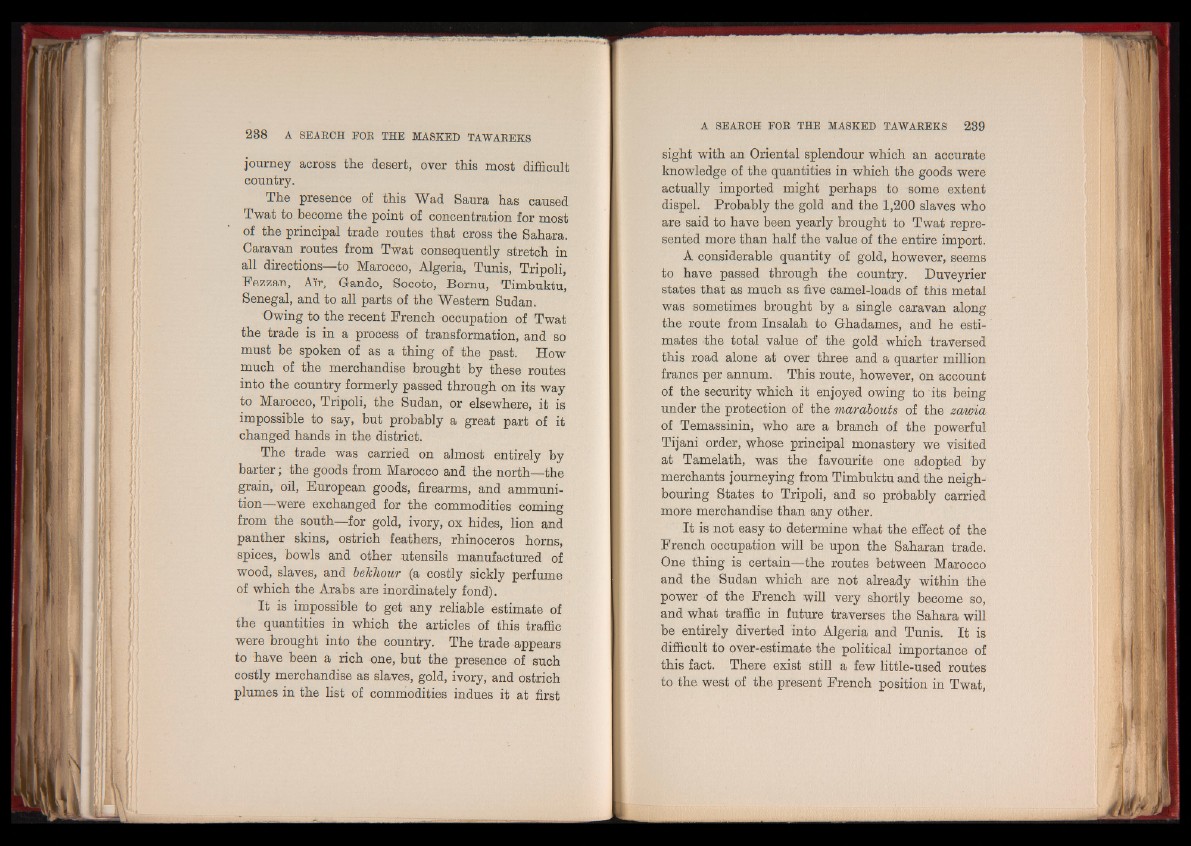
journey across the desert, over this most difficult
country.
The presence of this Wad Saura has caused
Twat to become the point of concentration for most
of the principal trade routes that cross the Sahara.
Caravan routes from Twat consequently stretch in
all directions—to Marocco, Algeria, Tunis, Tripoli,
Fezzan, Air, Gando, Socoto, Bornu, Timbuktu,
Senegal, and to all parts of the Western Sudan.
Owing to the recent French occupation of Twat
the trade is in a process of transformation, and so
must be spoken of as a thing of the past. How
much of the merchandise brought by these routes
into the country formerly passed through on its way
to Marocco, Tripoli, the Sudan, or elsewhere, it is
impossible to say, but probably a great part of it
changed hands in the district.
The trade was carried on almost entirely by
barter; the goods from Marocco and the north—the
grain, oil, European goods, firearms, and ammunition—
were exchanged for the commodities coming
from the south—for gold, ivory, ox hides, lion and
panther skins, ostrich feathers, rhinoceros horns,
spices, bowls and other utensils manufactured of
wood, slaves, and bekhour (a costly sickly perfume
of which the Arabs are inordinately fond).
It is impossible to get any reliable estimate of
the quantities in which the articles of this traffic
were brought into the country. The trade appears
to have been a rich one, but the presence of such
costly merchandise as slaves, gold, ivory, and ostrich
plumes in the list of commodities indues it at first
sight with an Oriental splendour which an accurate
knowledge of the quantities in which the goods were
actually imported might perhaps to some extent
dispel. Probably the gold and the 1,200 slaves who
are said to have been yearly brought to Twat represented
more than half the value of the entire import.
A considerable quantity of gold, however, seems
to have passed through the country. Duveyrier
states that as much as five camel-loads of this metal
was sometimes brought by a single caravan along
the route from Insalah to Ghadames, and he estimates
the total value of the gold which traversed
this road alone at over three and a quarter million
francs per annum. This route, however, on account
of the security which it enjoyed owing to its being
under the protection of the marabouts of the zawia
of Temassinin, who are a branch of the powerful
Tijani order, whose principal monastery we visited
at Tamelath, was the favourite one adopted by
merchants journeying from Timbuktu and the neighbouring
States to Tripoli, and so probably carried
more merchandise than any other.
It is not easy to determine what the effect of the
French occupation will be upon the Saharan trade.
One thing is certain—the routes between Marocco
and the Sudan which are not already within the
power of the French will very shortly become so,
and what traffic in future traverses the Sahara will
be entirely diverted into Algeria and Tunis. It is
difficult to over-estimate the political importance of
this fact. There exist still a few little-used routes
to the west of the present French position in Twat,